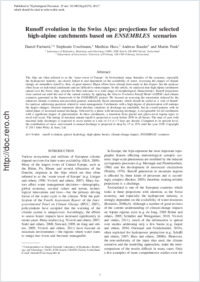Runoff evolution in the Swiss Alps: projections for selected high-alpine catchments based on ENSEMBLES scenario
- Farinotti, Daniel Laboratory of Hydraulics, Hydrology and Glaciology (VAW), ETH Zurich, Switzerland
- Usselmann, Stephanie Laboratory of Hydraulics, Hydrology and Glaciology (VAW), ETH Zurich, Switzerland
- Huss, Matthias Department of Geosciences, University of Fribourg, Switzerland
- Bauder, Andreas Laboratory of Hydraulics, Hydrology and Glaciology (VAW), ETH Zurich, Switzerland
- Funk, Martin Laboratory of Hydraulics, Hydrology and Glaciology (VAW), ETH Zurich, Switzerland
-
10.03.2011
Published in:
- Hydrological Processes. - 2012, vol. 26, no. 13, p. 1909-1924
English
The Alps are often referred to as the ‘water tower of Europe’. In Switzerland, many branches of the economy, especially the hydropower industry, are closely linked to and dependent on the availability of water. Assessing the impact of climate change on streamflow runoff is, thus, of great interest. Major efforts have already been made in this respect, but the analyses often focus on individual catchments and are difficult to intercompare. In this article, we analysed nine high-alpine catchments spread over the Swiss Alps, selected for their relevance to a wide range of morphological characteristics. Runoff projections were carried out until the end of the current century by applying the Glacier Evolution Runoff Model (GERM) and climate scenarios generated in the framework of the ENSEMBLES project. We focused on assessing the uncertainty induced by the unknown climate evolution and provided general, statistically based statements, which should be useful as a ‘rule of thumb’ for analyses addressing questions related to water management. Catchments with a high degree of glacierization will undergo the largest changes. General statements about absolute variations in discharge are unreliable, but an overall pattern, with an initial phase of increased annual discharge, followed by a phase with decreasing discharge, is recognizable for all catchments with a significant degree of glacierization. In these catchments, a transition from glacial and glacio-nival regime types to nival will occur. The timing of maximal annual runoff is projected to occur before 2050 in all basins. The time of year with maximal daily discharges is expected to occur earlier at a rate of 4·4 ± 1·7 days per decade. Compared to its present level, the contribution of snow- and icemelt to annual discharge is projected to drop by 15 to 25% until the year 2100.
- Faculty
- Faculté des sciences et de médecine
- Department
- Département de Géosciences
- Language
-
- English
- Classification
- Hydrology
- License
- License undefined
- Identifiers
-
- RERO DOC 27998
- DOI 10.1002/hyp.8276
- Persistent URL
- https://folia.unifr.ch/unifr/documents/302099
Statistics
Document views: 116
File downloads:
- hus_res.pdf: 265
